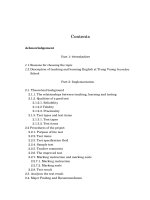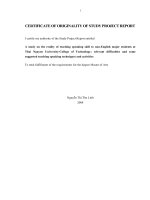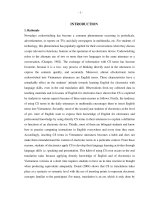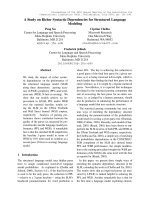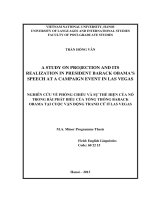A study on test taking techniques for toeic reading comprehension test by students at vietnam maritime university ics
Bạn đang xem bản rút gọn của tài liệu. Xem và tải ngay bản đầy đủ của tài liệu tại đây (691.71 KB, 61 trang )
VIETNAM NATIONAL UNIVERSITY, HANOI
UNIVERSITY OF LANGUAGES AND INTERNATIONAL STUDIES
FACULTY OF POST- GRADUATE STUDIES
----- -----
NGUYỄN THỊ BƯỞI
DEMOTIVATING FACTORS IN LISTENING LESSONS
OF THE SECOND YEAR NON-ENGLISH MAJOR STUDENTS
AT HANOI UNIVERSITY OF INDUSTRY
(Nghiên cứu về các yếu tố gây mất hứng thú trong các bài học nghe
của sinh viên không chuyên năm thứ hai trường đại học Công Nghiệp Hà Nội )
M.A. Minor Programme Thesis
Field:
English Language Teaching Methodology
Code:
60140111
HA NOI – 2015
.
VIETNAM NATIONAL UNIVERSITY, HANOI
UNIVERSITY OF LANGUAGES AND INTERNATIONAL STUDIES
FACULTY OF POST-GRADUATE STUDIES
----- -----
NGUYỄN THỊ BƯỞI
DEMOTIVATING FACTORS IN LISTENING LESSONS
OF THE SECOND YEAR NON-ENGLISH MAJOR STUDENTS
AT HANOI UNIVERSITY OF INDUSTRY
(Nghiên cứu về các yếu tố gây mất hứng thú trong các bài học nghe
của sinh viên không chuyên năm thứ hai trường đại học Công Nghiệp Hà Nội )
M.A. Minor Programme Thesis
Field:
English Language Teaching Methodology
Code:
60140111
Supervisor: Dr. Nguyen Thi Thu Ha
HA NOI – 2015
DECLARATION
I, hereby, certify the thesis entitled “Demotivating factors in listening lessons of
the second year non-English major students at Hanoi University of Industry” is the
result of my own research for the Minor Degree of Master of Arts at Faculty of PostGraduate Studies, University of Languages and International Studies, Vietnam
National University, Hanoi, and that this thesis has not, wholly or partially, been
submitted for any degree at any other universities or institutions.
Hanoi, October 2nd, 2015
Nguyen Thi Buoi
1
ACKNOWLEDGEMENTS
I would like to express my deepest gratitude to my supervisor Dr. Nguyen Thi
Thu Ha for her inspiring me to do this research. If it had not been for her invaluable
guidance, insightful comments and kind support, my thesis would not have been
accomplished.
My special thanks also go to all the professors and lecturers of the Faculty of
Postgraduate Studies at the University of Languages and International Studies –
Vietnam National University, Hanoi for their valuable lectures, which have laid the
foundation for this thesis.
I am indebted to my friends and my colleagues for their suggestions and
encouragement to fulfill the study. Finally, I owe the completion of this study to my
family, especially my husband who gave me encouragement throughout the study.
Hanoi, October 2015
2
ABSTRACT
This study is an attempt to investigate factors demotivating the second year non
English major students in listening lessons at Hanoi university of Industry. The main
purposes of the study are to find out: the main demotivating factor affecting students‟
motivation in listening lessons and some suggested solutions by teachers to stimulate
students to arouse their interest in listening lessons. The study data were collected by
means of questionnaire for students and teachers, informal interviews with
teachers and class observation. The results indicated that four demotivating factors
were found in this study: (1) unfavorable teaching and learning condition, (2) the
difficulty of listening section in the coursebook,(3) learner‟s lack of background
knowledge and reduced interest, and (4) teachers‟ teaching styles. However, there still
existed the gap between teachers‟ perception and students‟ perception as a source of
demotivation. The students mostly blamed on unfavorable teaching and learning
condition; whereas, teachers thought that it was the students‟ low English proficiency
and laziness in learning. Some suggestions were provided by the teachers to motivate
students in listening lessons.
3
TABLE OF CONTENTS
Declaration .......................................................................................................... i
Acknowledgements ............................................................................................ ii
Abstract ............................................................................................................... iii
Table of contents ................................................................................................ iv
List of abbreviations……………………………………………………………vii
List of tables and charts…………………………………………..……………viii
PART ONE: INTRODUCTION ..................................................................... 1
1. Rationale ......................................................................................................... 1
2. Aims and objectives of the study.................................................................... 2
3. Research questions ......................................................................................... 2
4. Scope of the study........................................................................................... 2
5. Research methodology ................................................................................... 2
6. Significance of the study ................................................................................ 3
7. Organization of the study ............................................................................... 3
PART TWO: DEVELOPMENT ..................................................................... 4
CHAPTER 1: LITERATURE REVIEW ....................................................... 4
1.1 Theoretical background of listening
1.1.1. Definitions of listening ...................................................................... 4
1.1.2. Definition of listening comprehension .............................................. 4
1.1.3. Teaching listening skill ...................................................................... 5
1.2 Theoretical background of motivation and demotivation ...................... 7
4
1.2.1Definition of motivation ...................................................................... 7
1.2.2 Definition of demotivation ................................................................. 7
1.2.3 Previous studies in the world and in Vietnam of demotivation ......... 8
1.2.4 Studies of demotivating factors in listening ....................................... 10
CHAPTER 2: METHODOLOGY ........................................................................ 13
2.1. Research questions .................................................................................... 13
2.2 Participants of the study ............................................................................ 13
2.3 Methods of the study .................................................................................. 13
2.4 Instruments ................................................................................................. 14
2.4.1 Questionnaire ...................................................................................... 14
2.4.2 Interview ............................................................................................. 14
2.5. Data collection and data analysis ............................................................. 14
2.5.1 Data collection .................................................................................... 14
2.5.2 Data analysis ....................................................................................... 15
CHAPTER 3: RESEARCH FINDINGS AND DISCUSSION ........................... 16
3.1. Data analysis of discussion of students‟ survey questionnaire .............. 16
3.1.1 The coursebook ................................................................................... 16
3.1.2 Student- related demotivating factors ................................................. 17
3.1.3 Teacher- related demotivating factors ................................................ 18
3.1.4 Teaching and learning conditions ....................................................... 19
3.1.5The demotivating items in rank order.................................................. 20
3.2 Data analysis and discussion of teachers‟ survey questionnaire and
interview ............................................................................................................ 23
3.2.1. Teachers‟ opinion on the role of listening comprehension, tasks,
students‟ proficiency in listening and students‟ motivation in listening ........... 24
3.2.2. Teachers‟ opinion on demotivating factors in listening lessons ........ 27
5
3.2.3. The frequency of teaching techniques and activities used by teachers in
listening lessons .................................................................................................. 29
3.2.4. Teachers‟ opinion on solutions helping students to revive their
motivation in listening lessons ........................................................................... 30
3.3 Major findings and discussion .................................................................. 33
3.3.1 Demotivating factors from students‟ perceptions............................... 33
3.3.2 Demotivating factors from teachers‟ perceptions............................... 35
3.3.3 Solutions suggested by teachers ......................................................... 37
3.4 Summary of the chapter .................................................................................. 37
PART THREE: CONCLUSION .................................................................... 38
1. Conclusion ...................................................................................................... 38
2. Recommandation ............................................................................................ 38
3. Limitation of the study ................................................................................... 40
4. Suggestion for further study ........................................................................... 40
REFERENCES ................................................................................................. 41
APPENDIX 1 (Student questionnaire – English version) .................................. I
APPENDIX 2 (Student questionnaire – Vietnamese version) ........................... III
APPENDIX 3 (Teacher questionnaire) .............................................................. V
APPENDIX 4 (Teacher interview- English version)………………………….VIII
APPENDIX 5 (Teacher interview- Vietnamese version) ................................... IX
6
LIST OF ABBREVIATIONS
HaUI: Hanoi University of Industry
LC : Listening comprehension
7
LIST OF TABLES AND CHARTS
Table:
Table 1: Students‟ opinions on listening comprehension section in the course book
Table 2: Students‟ opinions on student- related demotivating factors
Table 3: Students‟ opinions on teacher- related demotivating factors
Table 4: Students‟ opinions on teaching and learning conditions
Table 5: The rank order of 30 items of 4groups of demotivating factors
Table 6: Teachers‟ opinions on students‟ demotivation in listening lesson
Table 7:Frequency of teaching techniques and activities used by the teachers
Chart:
Chart 1: Teachers‟ opinions on the importance of listening skill
Chart 2: Teachers‟ opinions on the tasks in the coursebook
Chart 3: Teachers‟ opinions on students‟ proficiency in listening.
Chart 4: Teachers‟ opinions on students‟ motivation in listening lessons
8
PART ONE: INTRODUCTION
1. Rationale.
It goes without saying that English is an international language and has become
an useful tool for people in many fields of life. There is an increasing number of
learners trying to master English which is necessary for their jobs later. In Vietnam,
English is a foreign language that has been compulsory in schools and universities.
Learners are being trained to master the four skills: listening, speaking, reading and
writing. Learners are expected to use English successfully. However, there is a large
number of students who fail to fulfill that purpose.
As a teacher of English at Hanoi University of Industry, I found that my learners
have faced many problems in their learning process. Although the course‟s objective is
designed with a communicative orientation, non- English major students find it hard to
use English for daily communication. At Hanoi University of Industry, the secondyear non major English students are required to learn the course book “New Headwaypre intermediate”; however, many students feel bored and uninterested in listening
lessons because of some underlying reasons that need to be investigated.
A large amount of research on second language learning has mainly concentrated
on motivating factors with the aim of developing a positive attitude toward English
language learning. On the contrary, demotivation is considered to be a relatively new
term in this field. There have been so few studies conducted on demotivating factors in
learning second language in general, and in listening in particular. That is one of the
reasons why we carry out more research on this problem.
All the aforementioned reasons have encouraged me to carry out a study entitled
“Demotivating factors in listening lessons of the second year non- English major
students at Hanoi University of Industry”. I do this study with the hope that it will be a
useful reference for teachers and learners at HAUI to find a better way to teach and
learn listening skills.
9
2. Aims and Objectives of the Study
The study aims at exploring factors of demotivation in listening lessons of the
second year non- English major at Hanoi University of Industry.
The paper is intended to aim at the following objectives:
(+) To investigate main demotivating factors that reduce students‟ interest in listening
lessons.
(+)To suggest some solutions to eliminate these factors in order to help students
recover their interest in listening lesson.
3. Research questions
This study aims to answer the following question:
What are the dominant demotivating factors affecting students’ listening lessons from
students’ perception and from teachers’ perception?
4. Scope of the study
The study only focuses on the demotivation that the second year non-English
major students at HaUI have in their listening lessons. Then, the study is carried out to
investigate main demotivating factors in listening lessons, and to suggest some
solutions to help students overcome the current situation.
5. Research methodology
The study was a quantitative study, in which I used mainly quantifying
techniques. A little amount of qualitative analysis is added to offer deeper insight to the
quantifying results. Survey questionnaires were used to collect the data that show the
students' opinions and attitudes on the factors that demotivate them in listening lessons.
Informal interviews were applied to teachers to get information on their opinions and
their solutions to recover students‟ interest in listening lesson. Lastly, data from
observation in some listening classes were used for further analysis.
10
6 Significance of the study
Theoretical significance: As I have mentioned above, most of earlier studies in
second language acquisition mainly focused on motivation rather than on demotivation.
Moreover, there have been few studies on demotivating factors that prevent students
from learning English in a particular skill, especially listening skill. Therefore, this
study is hoped to offer new insight in this research area.
Practical significance: Findings of this study will provide information that can
help teachers and learners at HaUI find a better way to teach and learn listening skills.
In detail, the teachers are able to find appropriate teaching methods to motivate
students learning listening skill and students are aware of the factors that can help them
revive their interest in learning lessons.
7. Organization of the study
The study consists of three main parts: Introduction, Development and
Conclusion. The first part presents rationale, aims, scope, method, and design of the
study. The second part is the main content including 3 chapters. Chapter one is the
literature review which deals with the concepts of listening, listening comprehension,
demotivation and reviewing studies of demotivation in second language acquisition as
well as demotivating factors. Chapter two is about the methodology of the study which
presents research questions, participants, methods of the study, instruments, data
collection. Chapter three is about the data analysis, discussion and major findings. The
last part is conclusion which presents the summary of the study, limitations and the
suggestions for further study.
11
PART TWO: DEVELOPMENT
This part consists of three chapters. The first chapter presents the basic theories
related to listening, listening comprehension, demotivation. The next chapter is about
methodology which the author applies to conduct the research. In chapter three, data
analysis and discussion of the major findings are presented.
Chapter 1: LITERATURE REVIEW
1.1 Theoretical background of listening:
1.1.1Definition of Listening
According to Thomlison‟s (1984) listening is the ability to identify and
understand what others are saying. This process involves understanding a speaker‟s
accent or pronunciation, the speaker‟s grammar and vocabulary, and comprehension of
meaning. An able listener is capable of doing these four things simultaneously.
1.1.2 Definition of Listening comprehension
According
to
O‟malley,
J.M
&Chamot,
A.U.,
(1989),
“Listening
Comprehension is an active and conscious process in which the listener constructs
meaning by using cues from contextual information and existing knowledge, which
relying upon multiple strategic resources to fulfill the task requirement”.
Rost
(2002)
defines
listening
comprehension
as
follows:
“Listening
comprehension is regarded as a complex, interactive process in which listeners are
involved in a dynamic construction of meaning. Listeners understand the oral input
from sound discrimination, prior knowledge of vocabulary, grammatical structures,
stress and intonation, as well as other use linguistic, paralinguistic, or even nonlinguistic clues in contextual utterance”
12
From these definitions, we can conclude that in listening comprehension,
learners should be encouraged to concentrate on an active process of listening for
meaning, using not only linguistic cues but also his nonlinguistic knowledge.
1.1.3 Teaching listening skill
According to Byrnes (1984), listening is a highly-complex solving activity in
which listeners interact with a speaker to construct meaning, within the context of their
experience and knowledge. When students are made aware of the factors that affect
listening, the levels of listening, and the components of the listening process, they are
more likely to recognize their own listening abilities and engage in activities that
prepare them to be effective listeners. Karakas (2002) states that listening activities try
to prevent failure so that they can support the learner„s interpretation of the text.
Listening activities are usually subcategorized as pre-listening, while-listening, and
post-listening activities.
Pre-listening stage prepares students by getting them to think about the topic or
the text. Teacher may select certain words, difficult grammatical structures and
expressions to be explained through the discussion about the topic and may also ask
students to predict the content or what speakers are going to say, based on the
information they have
already got. Pre-listening activities usually have two primary
goals: (a) to help to activate students „prior knowledge, build up their expectations for
the coming information; and (b) to provide the necessary context for the specific
listening task.
In while listening process, listeners are more likely to construct clear and
accurate meaning as they interpret the speaker„s verbal message and nonverbal cues.
During the listening experience students verify and revise their predictions. They make
13
interpretations and judgments based on what they heard. Teacher may ask students to
note down key words to work out the main points of the text. Students answer
comprehension questions while listening to the text and select specific information to
complete the table provided with the text. While-listening activities usually have some
of the following purposes: to focus students‟ comprehension of the speaker„s language
and ideas; to focus students‟ attention on such things as the speaker„s organizational
patterns; to encourage students‟ critical reactions and personal responses to the
speaker„s ideas and use of language. An open-ended activity could follow that allows
students to have the freedom to practice listening comprehension in the class about
their daily life and asking for further information. Listening comprehension should
begin with what students already know so that they can build on their existing
knowledge and skills with activities designed on the same principle. A variation on the
filling in the missing word listening activity could be to use the same listening
materials, but to set a pair work activity where student A and student B have the same
worksheet where some information items are missing.
Post-listening activities are important because they extend students„ listening
skill. Post -listening activities are most effective when done immediately after the
listening experience. Well-planned post-listening activities offer students opportunities
to connect what they have heard to their own ideas and experiences, and encourage
interpretive and critical listening and reflective thinking. As well, post-listening
activities provide opportunities for teachers to assess and check students
„comprehension, and clarify their understandings; to extend
comprehension beyond
the literal level to the interpretive and critical levels. Different comprehension
questions can be assigned for students to discuss after listening, students then swap
information to complete the whole class chart, correlating what each student has heard
to arrive at the big picture. If there are any questions that remain unanswered during
14
the first or second listening, and after the information swap activity, the whole class
can listen to the tape again. The students will then try to find the answer to the
questions that have not been previously understood, rather than the teacher providing
the answers straight away.
1.2 Theoretical background of motivation and demotivation
1.2.1. Definition of motivation.
Researchers have different ideas in defining what motivation is, but all of them
agree that motivation is a very important factor that encourages students to enjoy their
studying.
Dornyei (2001) defined motivation as “a general way of referring to the
antecedents (i.e the causes and the origins”. Also, “motivation explains why people
decide to do something, how hard they are going to pursue it and how long they are
willing to sustain the activities”
According to Burden (1997) “from a cognitive perspective, motivation is
concerned with such issues as why people decide to act in certain ways and what
factors influence the choice they make. It also involves decisions as to the amount of
effect people are prepared to expand in attempting to achieve their goals. The role of
the teacher thus becomes one of the helping and enabling learners to make suitable
decisions”
1.2.2 Definition of demotivation
While motivation is learning second language is the target deal of research
during the past decades, demotivation seems to be a new issue of this field that has
recently inspired researchers.
According to Oxford Advance dictionary, “demotivate” means “to make
somebody feel that it is not worth making an effort” because there is something that
raises meaninglessness or worthlessness in their mind when doing anything they do not
15
want to pursue the task as well as try to perform it without any effort. Zhang (2007)
defines demotivation as the force that decreases students‟ energy to learn and/or the
absence of the force that stimulates students to learn”.
Dornyei (2001) defines demotivation as “specific external forces that reduce or
diminish the motivational basis of a behavioral intention or an ongoing action”. These
negative external factors consist of items such as the class environment, teaching
situations, methods, teachers‟ behaviors and so on.
Flout and Maruyama (2004) states that demotivation has a negative influence on
students, preventing from gaining expected learning outcomes. In other words,
demotivation causes learners lose their motivation in studying, which leads to
unsuccessful mastery of English language proficiency. Demotivation can be classified
into two main categories: external factors and internal factors. The former relates to
factors that come from outside such as teachers, learning conditions, learning materials,
grading and assessment, etc. The later results from students themselves include their
attitude toward English, their self-esteem, their experience of failure or lack of success,
etc.
1.2.3. Previous studies in the world and in Vietnam of demotivation
According to Dornyei (1998, 2001) there are nine demotivating categories in the
order of frequency as follows: the teacher, inadequate school facilities, reduced selfconfidence, negative attitude towards the second language, compulsory nature of
second language study, interference of another foreign language being studied,
negative attitude towards second language community, attitudes of group members and
course book.Dornyei‟s demotivating factors have been considered a standard and have
become the guideline in developing questionnaires and interviews in conducting
researches on demotivation of other researchers such as Chang & Hwang (2004),
Falout & Maruyama (2004), Kikuchi (2009), Sakai & Kikuchi (2009).
16
The research on demotivation in instructional communication studies is mostly
done by Gorham and Christophel. Gorham and Christophel (1992) tried to determine
what factors were deemed as demotives by college students while they tool
introductory communication classes. The findings showed that teacher-related factors
accounted for seventy –nine percent of all the responses. They also summarize a rank
of order of the frequency of the various demotives, with first five categories as
dissatisfaction with grading and assignments, the teacher being boring, the teacher
being unapproachable, self-centered, biased, condescending and insulting. This rank
offers a initiative insight into the true nature of teacher‟s role in demotivation.
In the field of second language motivation research, Chamber‟s study (1993)
was undertaken to explore demotivation among elementary students. The findings
showed that teachers perceived the causes of demotivation differently from how
students perceived them. Teachers perceived the causes of demotivation as related to a
variety of reasons: psychological, attitudinal, social, historical and geographical, except
for themselves. Students, on the other hand, blamed their teachers for: not giving clear
enough instructions, criticizing students, and shouting at them when they do not
understand.
Other studies also give further insight to student demotivation. Oxford (1998)
asked the participants to recall their learning experiences over a period of five years.
Four types of demotivation factors are discovered: the teacher‟s personal relationship
with the students; the teacher‟s attitude towards the course or the material; style
conflicts between teachers and students and the nature of the classroom activities. From
the analyses it is clear that his studies centers on the classroom learning and teacher‟s
demotivating roles. Many demotives were found such as teacher‟s lack of caring or
favoritism, teacher‟s lack of enthusiasm and sloppy management of irrelevance and
repetitiveness. The research shows that most teachers will easily attribute students‟
17
demotivation to various reasons including psychological, attitudinal, social, historical
and even geographical reasons with realizing the potential demotivating roles of
themselves.
Also, Sakai and Kikuchi (2009) aimed to investigate demotivating factors
among students studying in upper secondary school, Japan. The researchers found out
five factors that demotivate students such as inadequate school facilities, test scores,
lack of intrinsic motivation teacher‟s competence and teaching styles and learning
content and materials. In contrast to the previous studies, teacher-related factors were
not the most demotivating factors, that learning contents and materials and test scores
are the prominent demotivating factors for various students.
In Vietnam, Trang and Baldauf (2007) conducted a research on demotivation
from 100 university students in learning English. The students were asked to write an
essay of factors that demotivate them on learning foreign language. They found out
that both internal factors from students such as attitude toward English, experiences of
failure or lack of success, or self-esteem and external factors such as from teacher
(behavior, competence, methods, etc.) from learning environment (classroom
atmosphere, opportunities to use English, learning conditions, text books etc.) and
other demotivating factors such as obligation (compulsory nature of English, parents‟
interference) or negative changes (teacher replacements, learning environment
changes). The findings of their study seem to be similar to the previous study when it
stated that the biggest source of demotivation is relevant to the teachers.
1.2.4 Studies of demotivating factors in listening
According to Willis (1981) four factors: the message to be listened to, the
speaker, the listener and the physical setting are the reasons of listening difficulties
which in turn might make students become demotivated in listening.
18
Firstly, it is hard for students to listen to a taped massage than to read the same
messages on a piece of paper because they only have a little time to hear that message
meanwhile reading material can be read as long as the students like. Moreover, the
content of listening material is various and usually not well organized. There are a lot
of unfamiliar topics and situation. Therefore, in many cases listeners cannot predict
what speakers are going to say. Besides, messages on the radio or recorded on tape
cannot be listened to at a slower speed. In spontaneous conversations people sometimes
use ungrammatical sentences because of nervousness or hesitation. They may omit
elements of sentences or add something redundant. This may make it difficult for the
listener to understand the meaning.
Secondly, “redundant utterances of the speaker may take the form of repetitions,
false starts, re-phrasings, self-corrections, elaborations and apparently meaningless
additions such as I mean or you know” may make it more difficult for beginners to
understand the speaker is saying, on the other hand, it may give advanced students
more time to “tune in” to the speaker‟s voice and speech style as Ur (1984) stated in his
research. Also, learners tend to be used to their teacher‟s accent or to the standard
variety of British or American English, therefore they find it hard to understand
speakers with other accents.
Thirdly, the listeners as foreign-language students are not familiar enough with
clichés and collocations in English to predict a missing word or phrase. Besides, their
lack of socio-cultural, factual and contextual knowledge of the target language can
present an obstacle to comprehension because language is used to express its culture
(Anderson and Lynch 1988). It is easily seen that foreign- language learners usually
devote more time to reading than to listening, and so lack exposure to different kinds of
listening materials. Both psychological and physical factors may have a negative effect
on perception and interpretation of listening material.
19
Lastly, in terms of physical setting, background noises on the recording and
environment noises can take the listener‟s mind off the content of the listening passage.
Listening material on tape or radio lacks visual and aural environmental clues. Not
seeing the speaker‟s body language and facial expression makes it more difficult for
the listener to understand the speaker‟s meaning. Moreover, unclear sounds resulting
from poor- quality equipment can interfere with the listener‟s comprehension.
In Vietnam, Nhung (2012) also conducted a research to find out demotivating
factors in listening lessons of 10th grade students at No.1 Lao Cai High School. Two
survey questionnaires were delivered to 125 students and 4 teachers. Besides, the semistructured interview was conducted with 4 teachers to find out the techniques used by
teachers to motivate their students during listening lessons. The study show that factors
such as listening difficulties, teacher‟s style and competence, inadequate school
facilities, lack of target environment and exam- orientation were the main demotivating
factors that caused 10th grade students demotivated in listening lessons.
In conclusion, the researcher has reviewed some popular research on
demotivation in teaching and learning foreign/second language. It is clear that there are
a few studies on demotivating factors in listening lessons in particular. Each study
reflects different points in investigating demotivating factors because the researchers
used different ways to collect data in different contexts and subjects. However, from
these studies above, it can be concluded that demotivation varies from many sources
such as teachers, students, learning conditions etc. In Vietnam, there are very few
studies on demotivation in learning foreign language in general or in listening skill in
particular. Therefore, this study aims to find out factors that demotivate second year
non- English major at Hanoi university of Industry in listening lessons.
20
Chapter 2: METHODOLOGY
2.1 Research questions
This study is intended to seek the answer to the following research questions:
- What are the dominant demotivating factors affecting students in listening lessons at
Hanoi University of Industry from students’ perception and from teachers’ perception?
2.2 Participants of the study
There were two groups of participants: students and teachers
Group 1:155second year non- English major students at different classes such as
Electricity 1, Electronics 4 and Software Design1took part in the survey questionnaire.
Most of them have learnt English for nine years and a half as a compulsory subject.
They have six periods of English per week. Each period lasts 45 minutes. The
coursebook in use is “New headway- pre intermediate” which is taught by Vietnamese
teachers of English. Before working on this course book, the students had already
learnt the course book “New Headway- elementary”.
Group 2:20 teachers are working with listening lessons of New Headway- pre
intermediate, participated in survey questionnaires and 5 of them took part in the
informal interview. All of them have Bachelor degrees. Besides, they are the teachers
with at least more than three years of teaching experience.
2.3 Method of the study
The study was conducted quantitatively, in which I used mainly quantifying
techniques. A little amount of qualitative analysis was added to offer deeper insight to
the quantifying results.
The data were collected using survey questionnaires for
students & teachers, informal interviews for teachers. In this study, survey
questionnaires were used to collect the data that show the students' opinions and
attitudes on the factors that demotivate them in listening lessons. Informal interviews
were applied to teachers to get information on their opinions and their solutions to
recover students‟ interest in listening lesson
21
2.4 Instruments
To ensure the reality of the information gathered for the study, quantitative
methods and qualitative methods of research was employed with the following
instruments: Survey questionnaires for students and teachers and informal interviews
with teachers.
Questionnaires were designed basing on Likert scales model. The content of the
questionnaire was designed partly according to the results of related research and my
own teaching experience in reality. This form of question was used for both students
and teachers to find out the factors that demotivate students in listening lessons.
Informal interviews were used for teachers. All the questions in this interview
focused on finding out teachers‟ opinions and their appropriate techniques to recover
students‟ interest in listening lessons.
2.5 Data collection and data analysis
2.5.1 Data collection
To gain data for the study, two survey questionnaires (appendix 2 and appendix
3) were administered to the participants. A 30- item questionnaire was constructed
based on demotivating factors used by Dornyei (1998), Falout& Maruyama (2004),
Kim (2009) and Sakai and Kikuchi (2009) and the researcher‟s own investigation. The
items were designed to measure the four demotivating factors derived from previous
studies: 1) course book-related factors, 2) learner-related factors, 3) teacher- related
factors and 4) learning and teaching condition. The participants were asked to respond
to questions with choices ranging from strongly disagree, disagree, undecided, agree
and strongly agree. The participants were also asked to provide their background
information such as name, age and the years of learning English.
Informal interview (appendix 5) was carried out either at Faculty of Foreign
Languages or during the break time between two-period classes in the staff room for
the convenience. The interview lasted from 8 to15 minutes in Vietnamese for each
22
teacher to ensure mutual understanding between the teachers and the interviewer.
Informal interview questionnaires were constructed based on Kikuchi (2009). The first
question was about the participants‟ viewpoints on their students‟ attitude toward
listening lessons. The next question was based on the four demotivating factors. The
third question was about the activities and techniques applied by teachers. The last
question was about the solutions suggested by teachers to arouse students‟ interest in
listening lessons.
2.5.2 Data analysis
The data were analyzed quantitatively through Likert scale to explore the main
demotivating factors in listening lessons of the second year non-English major students
at HaUI.
The comment and perceptions made by teachers and students in response to the
questionnaires was consolidated and categorized by the researcher. The result was
converted to percentages for the convenience of analysis.
23
